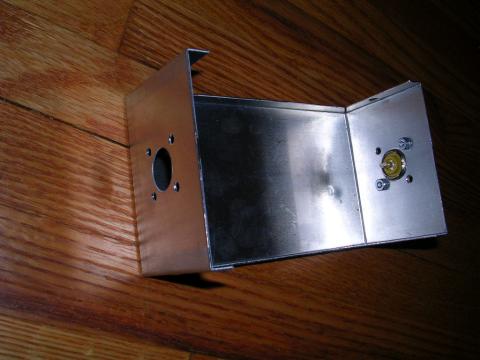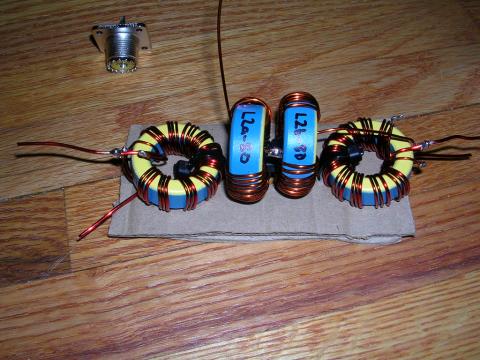Given that the most popular search hit for k8gu.com is "w3nqn", I thought I'd share a little bit about my experiences building the W3NQN bandpass filters.
Note that this article doesn't necessarily portray events in chronological order.
Outline- Motivation
- Component Selection
- Construction
- Measurement
Both of these articles are available through the ARRL TIS web site. You do not have to be an ARRL Member to access them.
- Wetherhold, "Clean up your signal with band-pass filters--Part I," QST May 1997.
- Wetherhold, "Clean up your signal with band-pass filters--Part II," QST June 1997.

So, you've reached the point in your contesting career that you can hold a run frequency but find yourself getting bored between callers and antsy about missing multipliers. Enter SO2R, single-operator, two-radios. [If you're new to this concept, there are plenty of other resources on the web. Essentially, you tune around looking for contacts with one radio while CQing on the other.]
I live on a typical urban lot. Thus, I don't have room to get good antenna separation to help me protect my radios (and ears) from each other. In fact, my first two antennas pass within inches. When I transmit at 100 watts on the 80-meter antenna, I have about 2.5 watts coming back down the 40-meter antenna. I can't imagine that would be good for my receiver, even after preselection.
Some sort of bandpass filter is in order. Of course, I was well-aware of the W3NQN filters from conversations with other contesters and reading about their stations. I also had the good fortune to be able to compare the competing commercial ICE and Dunestar filters on a network analyzer. These results are on the Engineering page. Based on those measurements and those provided in the W3NQN articles, plus some measurements on a preliminary W3NQN 160-meter filter I built, I decided that the W3NQN filters were indeed the ones to have. Of course, you pay for quality. Array Solutions carries the W3NQN filters for $95 per band. In true ham spirit, I reasoned that I could build them myself for far less.
Component SelectionThe amount of engineering and design that W3NQN put into his filters is staggering. His articles are thorough and methodical. Along with that comes the very precise selection of components. Unfortunately, the high-voltage capacitors and mix-17 iron-powder cores used in the filters are not readily-available through the usual distribution channels available to amateurs.
I was able to successfully obtain samples of the T130-17 cores from Micrometals. I actually tried to purchase them. But, apparently, it is cheaper for them to give away a few samples than fill a small order. I encourage you to support their business by pooling orders, if you decide to build your own filters. The cores ran in the $2.50 range for 50 pieces [Spring 2004 pricing]. You can purchase the T130-6 used in the 160-meter filter from several suppliers frequented by amateurs. If interest is shown, I may place an order for the T130-17 cores.
The Tusonix capacitors proved more difficult. I was able to obtain some literature from them, although the exact parts used by Wetherhold are no longer listed and I was unable to obtain pricing information. So, I ran to my stack of electronic parts catalogs [obtained free from work and much easier to use for component selection than the web]. Digi-Key carries Panasonic high-voltage capacitors that are reasonably-priced. Unfortunately, the Panasonic capacitors are not NP0/C0G nor do they come in the same values as the Tusonix capacitors. However, I've not yet noticed any ill effects from not having NP0, although I'm sure there is some temperature rise during operation. Did you know that Digi-Key was founded and is still owned by a ham? N5IN. That's your trivia reward for reading this far.
The connectors, magnet wire, and enclosures are all readily available. The total components cost, not including excess parts and mistakes, for one filter breaks down as follows: $6 capacitors, $15 cores, $4 mini-box, $6 connectors, $3 wire, for a total of $34/filter. With some scrounging, you can do it for less.
ConstructionThere's not too much to talk about here. I built the filters. If you don't have one, you should buy a 5/8" knock-out punch to make the holes for the connectors. Mine was made by Greenlee and I bought it from McMaster-Carr. It's far better than anything else. I used 1/4" long 4-40 screws to attach the connectors to the box. At the advice of K4OJ posted to the TowerTalk reflector several years ago, I use Amphenol connectors in all my new projects. Life is too short for cheap connectors or cheap coax.

I built the filters on a corrugated cardboard "breadboard" that serves to raise them above the bottom of the mini-box. I figured if cardboard was good enough for W3NQN, it was good enough for me. Although, I would like to replace it with something a little more "professional", nobody will see it unless it catches fire.

Here's what the finished product looks like inside.

When I was at University of Minnesota, I had 24/7 access to three HP vector network analyzers covering 30 kHz-50 GHz. But, no longer.
My preliminary measurements [using insertion loss measurements with an oscilloscope and a dummy load] estimate approximately 45 dB attenuation of the 80-meter fundamental with the 40-meter installed. This measurement was performed by transmitting on the 80-meter antenna with the 40-meter antenna terminated in a dummy load. An oscilloscope was used to measure the voltage [peak-to-peak or RMS, doesn't matter in this case] across the resistor. The same measurement was performed with the filter between the antenna and the dummy load. The insertion loss at the fundamental is estimated using the following equation:
If you are willing to make some component substitutions, the W3NQN filters are an excellent, economical, bandpass filter solution. They do take a while to build. Give yourself at least two-three hours per filter. I believe that my experience indicates that expensive test gear isn't necessary to build the filters. Although, access to a Network Analyzer is certainly beneficial if you'd like to know what's really going on inside.